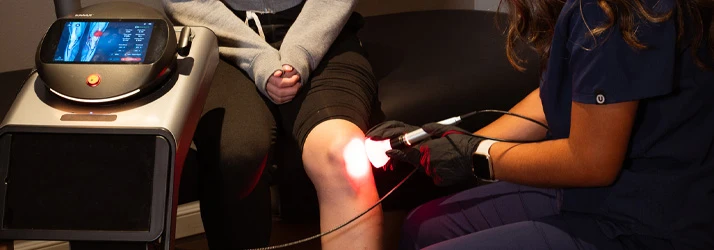LASER THERAPY IN Corona CA

Are you looking for cold laser therapy in Corona CA? In recent years, many medical and alternative health clinics have begun including light therapies in their traditional treatment methods. One of the most popular light therapies being used is cold laser therapy or low-level laser therapy. When tissues are damaged, cells begin to die and scar tissue formation often begins. Both of these consequences can slow or even limit the healing process. Modern-day cold laser units have been specifically engineered to produce the essential wavelengths of light necessary to stimulate the damaged cells, break up the formed scar tissue, and stimulate the healing process.
What Is Cold Laser Therapy in Corona CA?
Cold laser units come in various sizes and shapes. Often the units used are handheld and similar to the size of an average flashlight. The treatment time required is usually dependent on two factors, the condition being treated and the size of the area affected. A major advantage of cold laser therapy units is the ability to penetrate deep into tissues and joints while retaining the capability to also treat conditions closer to the skin surface. People utilizing cold laser therapy as a non-invasive form of treatment report feeling little or no sensation during the treatment process. Regardless of how deep the light waves penetrate, the energy is eventually absorbed by the damaged cell providing it with the boost to begin working. Plants using the sun's light to stimulate growth and healing is a good analogy to demonstrate the effects of cold laser therapy. As these cells are repaired, the body is able to decrease the sensation of pain, reduce swelling, and accelerate the time required to heal.
What can I use cold laser therapy for?
Due to the wide range of healing potential, our Richter Family Chiropractic team has been trained to utilize this technology for the treatment of many conditions. Some of the conditions that are commonly treated at our clinic include:
- Neck Pain
- Low Back Pain
- Foot Pain
- Carpal Tunnel Syndrome
- Knee Pain
- Various Tendonitis
- Painful Joints
- Fibromyalgia
- Arthritis
- Bursitis
- Various Forms of Acute and Chronic Pain
- ..... and many more
If you are interested in Cold Laser Therapy in Corona CA, watch the video below or contact our team at Richter Family Chiropractic today.
OFFICE HOURS
Monday
8:00am - 5:30pm
Tuesday
8:00am - 5:30pm
Wednesday
By Appointment
Thursday
8:00am - 5:30pm
Friday
Closed
Saturday
By Appointment
Sunday
Closed
Richter Family Chiropractic
854 Magnolia Ave # J
Corona, CA 92879



